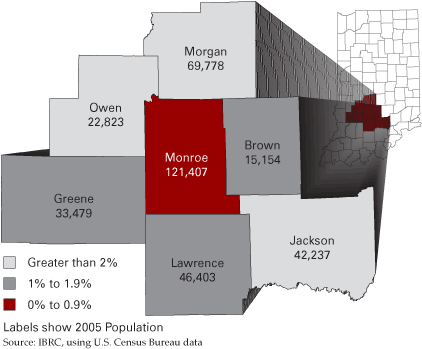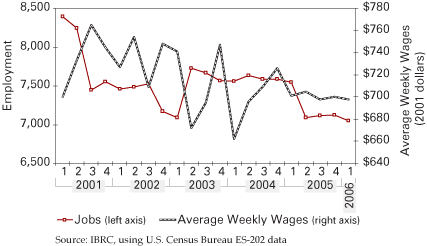Bloomington
Indiana Business Research Center, Kelley School of Business, Indiana University
The Bloomington area’s economy followed in the state’s footsteps in 2006, and it appears on track for moderate growth in the year ahead.
Monroe County’s population, estimated at 121,407 in 2005, continued its slow growth, adding nearly 500 residents over the preceding year (but gaining only 844, or 0.7 percent, since the 2000 Census). Though the county is growing, Monroe’s neighbors are all growing at a faster rate, as shown in Figure 1. In contrast, the city of Bloomington’s population (estimated at 69,017 in 2005) continued its gradual shrinkage, dropping over the year by about 300 and down 2,600 (3.5 percent) since 2000.
Figure 1
Population Growth in Monroe and Surrounding Counties, 2000 to 2005

Employment in the area has continued growing at a moderate but encouraging pace, with the annual average for the Bloomington metropolitan area hitting an all-time high in 2005 at 81,436 nonfarm jobs. To date, 2006 is on track to surpass this mark, averaging more than 700 jobs above the year-earlier period on a seasonally adjusted basis through September.
This moderate employment growth has outpaced population growth over the past several years. Sustaining this trend required either more workers commuting to the Bloomington metro area from surrounding communities or a decrease in the unemployment rate, and both actually occurred. According to Indiana Department of Revenue data, 15,748 Monroe County workers commuted in 2004 from residences in other counties, up a slight 2.4 percent since 2000. The county’s unemployment rate, meanwhile, has been down every month in 2006 compared to a year earlier, a welcome trend as more “help wanted” signs are visible all over town. The September figure of 3.7 percent was Monroe County’s lowest unemployment rate in two years.
The local employment outlook for 2007 calls for a moderate gain in the range of 600 to 1,000 jobs. At this writing, no major plant expansions or closures have been announced for Bloomington in the coming year, although it appears that several firms in the automotive parts industry are considering locating in this general region of the state (in anticipation of the new Honda plant to be built in Greensburg and demand from other nearby auto plants).
The area’s manufacturing sector has declined substantially in recent decades, though the rate of manufacturing job shrinkage slowed significantly over the past year. As shown in Figure 2, the county lost nearly 1,000 factory jobs during the first half of 2001, and levels have since fluctuated in the low-7,000 range. With luck, we may actually see modest growth in local manufacturing jobs in 2007. Average wages paid to manufacturing workers in Monroe County have stabilized somewhat over the past several quarters after several years of sizable fluctuations. However, the overall trend for manufacturing wages is still slowly decreasing.
Figure 2
Monroe County Manufacturing: Jobs and Real Wages, 2001 to 2006
Respectable growth is expected in Bloomington’s life sciences industry, accounting for perhaps 300 to 500 new jobs in 2007 spread among the larger firms in this sector. Even more new jobs are likely in the health care services sector. Feeding the new hospital and growing demand for health care generally, this trend is not likely to abate anytime soon. Maintaining growth in health services and life sciences implies a growing demand for skilled workers; fortunately, new initiatives to meet this demand on the part of Indiana University (IU) and Ivy Tech should support continued growth.
With IU enrollments rebounding this fall and some significant investments in campus construction, research and other activities, businesses that cater to the higher education community have decent prospects for the coming year.
Finally, the Bloomington housing market is on track to finish 2006 with sales at about the same level as 2005, while prices to date are up about 4 percent and inventory on the market is slowly rising. Given the broader outlook for interest rates and the economy generally, 2007 should see home prices and sales leveling off and a gradual slowing of new housing construction.
Also in this Issue…
- Outlook for 2007
- The International Economy
- The U.S. Economy
- Financial Forecast
- Housing
- Indiana Agriculture
- Indiana
- Anderson and Muncie
- Bloomington
- Columbus
- Evansville
- Fort Wayne
- Gary
- Indianapolis
- Kokomo
- New Albany
- Richmond
- South Bend and Elkhart-Goshen
- Terre Haute
- Indiana Metro Economies at a Glance
- Return to Table of Contents




